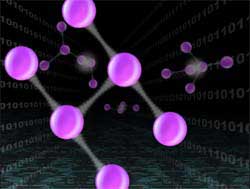| Posted: February 27, 2007 |
Researchers create largest ever photonic 'Schrödinger cat' |
|
(Nanowerk News) Chinese Academy of Sciences (CAS) researchers have been successful in their experimental entanglement of six photons in graph states: a "Schrödinger cat" state, and a "cluster" state. By creating two important examples of such states, according to experts, the studies have paved the way for the research into the fundamental issues in quantum computing, quantum error correction and quantum mechanics.
|
 |
|
In 1935, Erwin Schrödinger proposed a famous thought experiment in which a cat was somehow both alive and dead at the same time. The experiment involves a sealed box (allowing no interference from the outside), which contains a cat, and a closed canister of poisonous gas. Attached to the gas canister is a mechanism containing a radioactive nucleus. When the nucleus decays, it emits a particle that triggers a mechanism which opens the canister, thereby killing the cat. Since the nucleus, as long as it remains unobserved, is in a superposition of the "decayed" and "not decayed" states, then it logically follows that the cat must also be in a superposition of "alive" and "dead" states – until the moment when the box is opened.
|
|
Although the principle of superposition doesn't extend to such large objects and the Schrödinger cat state is nowhere to find in the macroscopic world, physicists are able to make hypothetical cats from small groups of photons or atoms.
|
|
Recently, as reported in a recent issue of Nature Physics, PAN Jianwei and his colleagues from the Hefei National Laboratory for Physical Sciences at Microscale at the CAS affiliated University of Science and Technology of China and institutions from Germany and Australia have created two types of six-photon graph state: a six-photon Greenberger-Horne-Zeilinger state, which is the largest photonic Schrödinger cat so far, and a six-photon cluster state, which is a state-of-the-art 'one-way quantum computer. Both of these break records for the number of photons entangled in such a manner: the cat state was previously five photons, and the cluster state was previously four.
|
|
However, the six-photon cluster state is likely to be of more importance, says LU Zhaoyang, lead author of Nature Physics article and a physicist from USTC. Standard quantum computation is based on sequences of unitary quantum logic gates, where a major difficulty lies in the implementation of dynamical operation, Lu was reported as saying. "Cluster-state quantum computation does not need any dynamical operation."
|
|
Entanglement, an exotic phenomenon in quantum physics, is a state when particles are mixed that the measurement of one affects the state of another. In addition to the fundamentals for the quantum mechanics, it is a core technology for quantum information processing. Scientists have discovered that the entanglement of multi-photon entanglement is necessary for the development of a quantum computer with super computability. In a large extent, the level of such manipulation represents the capacity of a country for quantum computing.
|

